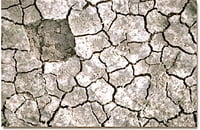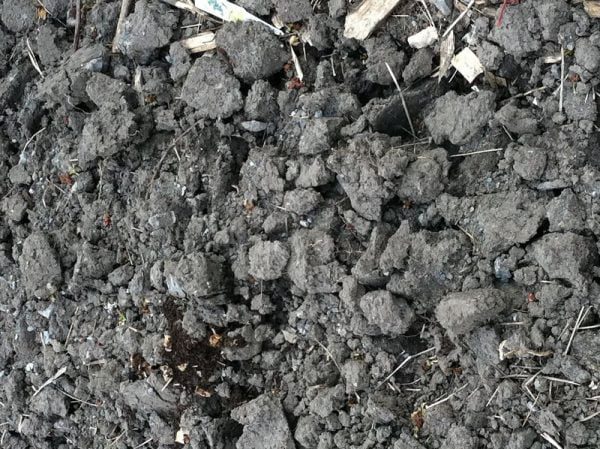How to Work With Wet Clay Soil
 How to Work With Wet Clay Soil (Or, How to Avoid Premature Cultivation)
How to Work With Wet Clay Soil (Or, How to Avoid Premature Cultivation)
One of the biggest mistakes gardeners make is trying to “work” (till up, cultivate, or hoe) their high clay content garden soil before it is dry enough to be worked. When you do this, the soil structure is broken down and you end up with rock-hard crusts or clumps when the soil dries.
After a long winter of snow and a rainy spring, clay beds are swelled with water, causing free clay particles float to the top and bond with each other. As the clay dries out further, a hard crust forms, which eventually starts cracking like you can see in the photo on the right. This can happen even if there is a lot of compost or organic matter in the soil.
To get the beds ready for planting, most gardeners will till or turn over their soil, perhaps mixing in more compost, fertilizer, or organic material. However, if you do this before the soil has dried out enough, you are going to run into problems.
The picture below shows a bed a week after it was turned over with a shovel and left to sit and dry out.
What has happened is that instead of the loose and crumbly structure you were expecting, the surface is now covered by hard lumps of clay–some of them 2 inches and larger. The reason this happens is because the wet clay was not dried out enough before tilling, so water is still filling spaces where air would be if the clay was drier. Now the clay, which is still too wet and sticky, will not crumble apart the way we want it to. It splits into clumps instead, and as these clumps dry out they become extremely hard.
Many gardeners have experienced the disappointment of having their soil look worse after turning it over than it did beforehand. It happens all over the country on all types of clay soils. Northern gardeners especially, who need to wait all winter and much of the spring for their cold and wet soils to dry out, are probably more guilty of “premature cultivation” than their southern counterparts.
How do I know when my soil is ready?
So, how do you tell when your soil is ready to be worked? It’s simple: take a handful of soil and squeeze it into a ball. Then, try to break it apart between your fingers, and see if it separates easily. We like to compare it to the feel of a handful of moist raisins that will clump together when squeezed, but will break apart with a quick rub of the fingers. If your soil stays clumped and doesn’t crumble, it is still too wet to work.
Eventually your clay soil will dry out enough to work. It may be very late into the spring before that occurs. However, since the top inch or two of soil will warm up and dry out faster than the deeper areas, you can usually do some seeding or shallow planting a few weeks earlier. If you do plan to till, make sure the soil has dried all the way down to the depth that you plan to dig down to.
Salvaging a bad situation
If you found this article too late, or if you just can’t wait long enough for all or part of the garden to dry out before cultivating it, don’t worry! There’s still hope. If you do till or dig up a wet soil, there is one thing you can do that will probably prevent the hard crusting on top: after cultivating, smooth out the soil and cover it with a layer of mulch, about 1/2 -1 inch thick or more. Use anything that will keep the clay from drying too fast on top. Shredded bark, leaves, straw, pine needles, compost, or even peat moss will do.
Improving Clay Soils
When you have improved your clay soil it will drain faster and will warm up earlier in the spring, which means it will be workable earlier in the year. There are many things you can do to improve clay soils, including raising the beds (to allow for better drainage) and, especially, adding lots of organic matter. Organic matter is critical. Without it, there is no humus. By adding organic matter and improving aeration as well, you will create an environment that allows beneficial soil life to start working to restructure the soil and form valuable humus.
Many gardeners today, including myself, are doing no-till gardening. Instead of tilling the soil they are keeping a permanent organic mulch on top of their garden beds. By maintaining a couple of inches of shredded leaves, wood chips, straw etc., on top of the beds you will protect the soil from drying out and will provide organic matter for earthworms and microbes to decompose. You can still easily fertilize the soil with liquid nutrients or compost, and do foliar feeding throughout the season to get nutrients to plants at the proper times of the season.
Clay soil is a big problem all over the country, which is one of the reasons we created our non-toxic lawn and garden product lines. Customers all over the US can improve clay and compacted soil with our Aerify PLUS, Nature’s Magic, and other soil conditioning products. They can be applied right over the top of mulched beds, or directly to bare soil. These products make a real difference, and help make everything else you are doing for the soil work a lot better.
Soil improvement is our favorite topic because whether it is a lawn or a garden, it all begins with the soil.
 How to Work With Wet Clay Soil (Or, How to Avoid Premature Cultivation)
How to Work With Wet Clay Soil (Or, How to Avoid Premature Cultivation)


